12 recipes for healthy eyes
- Broccoli rabe with tempeh and pine nuts
- Chicken chopped salad
- Chilled springtime soup sippers
- Deli-style kale salad
- Infused water
- Pumpkin mousse
- Salmon with mango salsa
- Sunset gazpacho
- Tangy carrot salad
- Tropical post-run smoothie
- Turkey burger with roasted orange peppers
- Veggie frittata with orange pepper, spinach and sundried tomatoes
- Who Created Our Eye-Healthy Recipes?

The next time you visit your eye doctor, don't be surprised if you leave with a prescription for a grocery cart full of kale, orange peppers and wild salmon. These and many other foods contain high amounts of nutrients that are important for the health and function of your eyes.
In this section, you'll find several great recipes designed to boost your eye health. The links are below. Enjoy!
Broccoli rabe with tempeh and pine nuts
This side dish features eye-healthy broccoli rabe, which contains significant amounts of vitamins A and C, as well as lutein and zeaxanthin. Chefs love broccoli rabe for its beautiful green color and hearty texture that pairs well with any meat, fish or poultry dish.
We've added a shot of protein to this recipe with tempeh, a fermented soy product that is widely available in natural food stores and now in many supermarkets. Usually you see it packaged in eight-ounce slabs. Tempeh has a bland, slightly nutty taste, and in our recipe we soak it in a sweet and salty mixture to give it more flavor. When toasted in a hot skillet, it makes a crispy, nutritious addition to just about any sautéed vegetable.
The chicken stock mellows the slightly bitter taste of the broccoli rabe — a trick we borrowed from Italian cuisine. You can make this dish vegan by using vegetable stock instead.
Broccoli Rabe with Tempeh and Pine Nuts (serves 4)

4 ounces tempeh, chopped into small bits 2 Tbsp tamari (or low-sodium soy sauce) 1 Tbsp agave nectar (or honey) Olive oil 1/4 cup pine nuts 1-1/2 pounds broccoli rabe with stem ends removed 1 shallot, chopped small 2 cloves garlic, sliced thin 1/3 cup chicken stock Salt and pepper 1/2 tsp pepper flakes
Mix the soy sauce and agave nectar in a bowl, then add the tempeh and let soak for five or 10 minutes.
Heat a tablespoon of olive oil in a small skillet over moderate heat. Add the tempeh and sauté for a few minutes until it begins to look crispy. Add the pine nuts and continue cooking for a minute or two, until they are browned. Remove from heat.
Heat a large pot of salted water to boiling. Place the broccoli rabe in the pot, cook for a minute, then remove from heat and drain well.
Sauté shallot and garlic in two tablespoons of olive oil in a large skillet over moderate heat. After two minutes, add the broccoli rabe. Cook until it's beginning to brown, about four minutes. Add the chicken stock, and toss to coat. Cook on high until the liquid boils away, then remove from heat.
Salt and pepper to taste, then toss with the pepper flakes. Sprinkle the tempeh and pine nuts over the top, and serve.
Chicken chopped salad
This eye-catching, vitamin-packed salad makes a great addition to any outdoor lunch! Loaded with lutein and zeaxanthin, vitamin C, vitamin E and zinc — it will feed your eyes as well as your vision. Prepare it in a flash by using leftover chicken from your weekend barbeque.
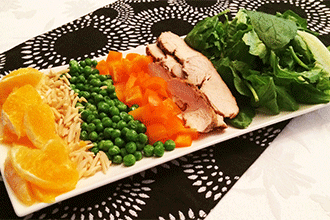
Chicken Chopped Salad (serves 1 as a main dish)
1 cup romaine lettuce, chopped in bite-size pieces 1 cup baby spinach 1 cooked chicken breast, sliced diagonally 1/2 cup frozen peas 1/2 orange pepper, diced 1/4 cup slivered almonds 1/2 orange, peeled then chopped
Dressing: 1/4 cup plain nonfat Greek yogurt 1 Tbsp curry powder 1 garlic clove, minced juice from remaining half of orange salt and pepper
Arrange ingredients on a plate or in a bowl. In a separate container, combine all dressing ingredients and stir until well-mixed. Drizzle dressing over top and serve.
Chilled springtime soup sippers
Chilled soup sipper or juice? This versatile recipe by chef Anna Olson can work both ways.
The green peas are full of vitamin C, with a significant amount of vitamin A as well. The apples and leafy greens contain other important nutrients for eyes.
The mint is a good source of several antioxidants. And the Greek yogurt offers a beneficial dose of protein.
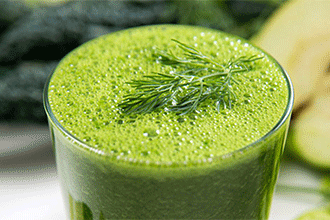
Niagara Springtime Soup Sippers (makes about 6 cups)
1 English cucumber 2 Granny Smith apples 1 lime, peeled 4 cups loosely packed spinach leaves 4 cups loosely packed baby kale 2 cups fresh or thawed frozen peas 2/3 cup loosely packed mint leaves 1-1/2 cups plain Greek yogurt honey, to taste lightly toasted sliced almonds, as garnish
Wash all of the vegetables and fruits thoroughly. Cut the cucumber and apple into large pieces.
Push all of the ingredients except the yogurt, honey and almonds through a juicer.
Whisk the juice into the Greek yogurt and add the honey to taste.
Pour into bowl or little glasses for sipping, and top with the toasted almonds.
Deli-style kale salad
Green vegetables, especially leafy greens such as kale, spinach and collard greens, contain high amounts of lutein and zeaxanthin. These pigments are powerful antioxidants that protect the retina from the damaging effects of UV rays.
Leafy greens also contain a lot of vitamin C, vitamin E, beta-carotene, zinc and fiber. These additional nutrients help prevent the progression of age-related macular degeneration (AMD).
Kale is the superstar of leafy green vegetables and is the feature of this eye-healthy recipe. This salad was inspired by the popular coleslaws that are served in delicatessens everywhere.

Deli-Style Kale Salad (serves 4)
4 cups raw kale, thoroughly washed and dried 1/4 cup chopped dried figs or dried apricots 4 green onions, finely sliced 1 medium carrot, shredded 1/4 cup roasted soybeans
Dressing: 2 Tbsp mayonnaise 2 Tbsp plain yogurt 2 tsp vinegar (apple cider vinegar, white wine vinegar or rice vinegar) 2 tsp honey or maple syrup salt and pepper
Remove ribs from kale leaves.
Roughly chop kale into bite-sized pieces (1-2 inches) and place into a large salad bowl.
Toss together all ingredients of the salad except the roasted soybeans.
In a small bowl, mix together all dressing ingredients. Pour over the salad and toss.
Cover and refrigerate for 1 hour or up to 3 hours.
Sprinkle with roasted soybeans and enjoy.
Infused water
Stay hydrated! Drinking plenty of water throughout the day is important for several reasons — including eye health. Dehydration can lead to dry eyes, red eyes and puffy eyelids.
Follow these simple steps to create delicious and refreshing infused water for the whole family. These drinks are especially great during hot summer days and are a healthy alternative to soda.
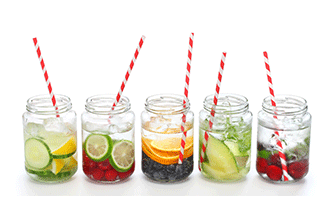
Eye-Healthy Infused Water
Choose a glass pitcher or jar.
Add a handful of chopped herbs from the list below.
Choose one or two fruits and veggies from the list below. Slice and add to the pitcher.
Fill the container with filtered water and let it sit in the fridge for two hours so the flavors can infuse into the water.
Herbs and spices: Mint, basil, rosemary, ginger.
Fruits and vegetables: Cucumber, fennel, strawberries, blueberries, raspberries, lemons, limes, oranges, kiwi, peaches, watermelon, mango.
Dr. Laurie Capogna's favorite combinations: cucumber and mint; strawberry and basil; peach, kiwi and basil.
Tips: The water will last for up to three days; however, the fruit and veggies may get water-logged within a day. If you haven't finished it all in 24 hours, then strain the produce out.
Pumpkin mousse
This fall, trade your traditional pumpkin pie for this lighter dessert. Filled with beta-carotene, it will nourish your eyes and satisfy your sweet tooth.

Pumpkin Mousse (serves 4) 1 cup pumpkin puree from can (240g) 1/2 cup plain 0% or 2% fat Greek yogurt 1/2 cup maple syrup 1/4 cup freshly squeezed orange juice 1 envelope gelatin 1/4 cup whipping cream, very cold zest of one orange 1/2 tsp mixed spice (cinnamon, clove, nutmeg, ginger)
Put medium bowl in freezer.
In a large bowl, mix pumpkin and yogurt, using a whisk.
Sprinkle gelatin on orange juice and let sit for about three minutes, just enough time to get maple syrup ready.
Bring maple syrup to a boil on medium-high heat in a small sauce pan, stirring constantly.
Pour boiling maple syrup over orange juice and stir until gelatin has melted.
Pour maple syrup mix into pumpkin preparation and mix well, using a whisk.
Add orange zest and spices; stir to combine.
In chilled bowl, whip cream to firm peaks, using a hand mixer.
Use your mixer to whip pumpkin mix for about one minute.
Fold whipped cream gently into pumpkin mix, using a spatula.
Ladle into serving cups and chill in the refrigerator for two to three hours, until set.
Salmon with mango salsa
Eating fish is important to the health of your eyes because fish contain the omega-3 fatty acids DHA and EPA. In the eye, DHA and EPA have an important role in vision and help decrease inflammation. Researchers have found that eating cold-water fish has protective effects against age-related macular degeneration, cataracts and dry eye syndrome.
The most effective way to get DHA and EPA into your diet is to eat cold-water fish that are high in these omega-3 fatty acids and also low in contaminants. Wild Alaskan salmon, sardines, rainbow trout, and mackerel are all excellent choices.
This delicious salmon dish makes a great weeknight dinner. Its vibrant, bright presentation also makes it a hit at dinner parties. If you are dining outdoors, don't forget to wear your sunglasses!
P.S. Not a big fan of cantaloupe? Use peaches or papaya in this recipe instead!
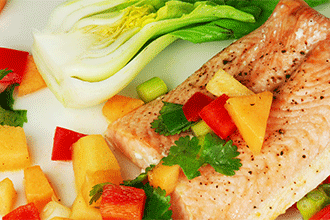
Roasted Salmon with Melon Salsa (serves 4)
4 wild Alaskan salmon fillets (frozen or fresh) 1 Tbsp olive oil salt and pepper
Melon Salsa: 1 cup cantaloupe (cut into 1/4-inch cubes) 1/2 red pepper (cut in 1/4-inch cubes) 1 green onion, chopped finely 1 Tbsp fresh cilantro, chopped salt and pepper juice and zest of 1 lime 1 Tbsp olive oil
Preheat oven broiler to 400 degrees (or maximum).
Line a cooking sheet with aluminum foil.
Place fish fillets on the cooking sheet and brush with olive oil. Sprinkle a little salt and pepper on each fillet.
Place in oven for 5-10 minutes, or until brown on the top and cooked throughout.
While the salmon is cooking, prepare the salsa:
Mix together gently the cantaloupe, green onion, red pepper and cilantro. Season with a little salt and pepper.
In a small bowl, whisk together the olive oil, lime zest and lime juice.
Poor dressing over salsa and mix to combine.
When salmon is ready, place one fillet on each plate and spoon one quarter of the salsa on top. Serve with a green salad and brown rice.
Sunset gazpacho
Load up on lutein and zeaxanthin, beta-carotene and vitamin E with this refreshing cold soup made of our favorite orange vegetables. Perfect for a cocktail party.
The soup also contains Vidalia onions, which are rich in vitamin C. Despite the egg garnish, this recipe contains very little fat or cholesterol, and it's so flavorful that you probably won't want to add much salt.

Sunset Gazpacho (makes about 6 cups)
2 orange peppers, stems and seeds removed 2 lbs orange tomatoes, cut in half 1/2 small Vidalia onion, roughly chopped 1 cup fresh carrot juice 1 garlic clove 3-4 Tbsp extra virgin olive oil 2 tsp sherry vinegar salt and pepper finely grated hardboiled egg, for garnish
Puree the peppers, tomatoes, onion and carrot juice in a blender until smooth.
Add the sherry vinegar, and while blending, drizzle in the olive oil.
Season to taste, and chill until ready to serve.
To serve, pour the soup into dishes and top with the grated egg.
Tangy carrot salad
This colorful salad is a great holiday side dish and can liven up your leftover meals as well. Carrots are full of eye-healthy beta-carotene and also contain significant amounts of fiber, potassium and vitamin C.
Other ingredients provide eye nutrients like zinc, lutein and protein (if you add the chickpeas).
Fresh orange juice is more nutritious, but the concentrate has a deeper tang that brightens the flavors.
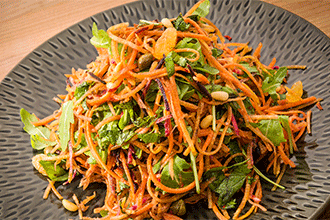
Tangy Carrot Salad (serves 4)
1/2 cup pumpkin seeds, pine nuts or sunflower seeds 8 large carrots 1-1/2 cups rocket or romaine lettuce, chopped 1/2 cup dried cranberries, cherries or golden raisins
Optional Add-Ins: 1/4 cup pitted dates, chopped small 1/4 cup canned beets, drained and julienned 1/2 cup canned chickpeas, drained
Dressing: 1/3 cup frozen orange juice concentrate, thawed 2 Tbsp lime juice 3 Tbsp extra-virgin olive oil 1 tsp ground cumin 1/4 tsp cayenne pepper Salt and pepper to taste
Toast the nuts or seeds in a dry skillet over medium heat for 2 or 3 minutes, until golden brown (don't let them burn). Salt lightly if desired, remove from pan and let cool.
You can either grate the carrots or make long ribbons of them with a vegetable spiralizer or peeler. Place in a large bowl with the lettuce, dried fruit, and any other add-ins you choose. Mix well.
In a small bowl, mix together the dressing ingredients. Pour over salad in large bowl and toss. Sprinkle the toasted nuts or seeds over the top, and serve.
Tropical post-run smoothie
Exercise, then drink this! This refreshing treat is packed with lutein, zeaxanthin and vitamin C.

In addition to feeding your eyes, the coconut water will replenish your body with much-needed electrolytes after a summer run or workout.
Tropical Post-Run Smoothie (serves 4)
3/4 cup frozen mango 1/4 cup frozen pineapple 1 cup spinach / kale 1 cup coconut water
Place all ingredients in a blender. Blend and enjoy!
Turkey burger with roasted orange peppers
These healthy turkey burgers will turn your weekend barbeque into an eye-healthy feast! Turkey is high in zinc, and the orange peppers and green onion will provide your eyes with lutein and zeaxanthin.
For a lighter version, omit the whole-wheat buns and enjoy your turkey burger wrapped in lettuce leaves.

Turkey Burgers with Roasted Orange Peppers (serves 4)
1 lb ground turkey (extra-lean) 1 egg 1/2 cup green onion, chopped 1/4 cup whole wheat bread crumbs or oat bran 1/4 cup chopped flat-leaf parsley salt and pepper
Toppings: 2 orange peppers 3 Tbsp Dijon mustard (grainy) leaf lettuce
4 whole-wheat burger buns
Caramelized Onions (optional): 2 yellow onions olive oil
Mix all ingredients for the burgers. Shape into four patties. Place each patty on a square of parchment paper, and set aside in the refrigerator.
Preheat the grill to high. Put the peppers on the grill, turning until charred on all sides. Remove them from the grill and place in a paper bag. Close the bag tightly and let cool for about 10 minutes. The steam will help separate the skin from the peppers so they are easier to peel.
Once the peppers are cool enough to handle, and working over a bowl to collect the juices, peel the peppers. Cut in wedges and remove the stems, seeds and white membranes.
Set aside roasted pepper wedges. Mix 1 tablespoon pepper juice (that you collected while peeling the peppers) with 3 tablespoons grainy Dijon mustard.
Holding onto the parchment paper, flip turkey patties on the grill and cook on each side, until they reach an internal temperature of 160 degrees (as recommended by the FDA).
When patties are almost ready, toast outside of burger buns on the grill.
To assemble burger, spread the mustard mix on both sides of the buns. Add roasted pepper wedges. Layer the patty next. Top with leaf lettuce.
Optional: Prepare caramelized onions ahead of time: Cook thinly sliced yellow onions over low heat in olive oil for about 20 minutes, or until very tender. Season with salt and pepper.
Enjoy with coleslaw enriched with kale.
Veggie frittata with orange pepper, spinach and sundried tomatoes
Parents, tell your children to eat orange peppers for their eye health! This versatile vegetable is a great source of zeaxanthin — a protective carotenoid that is concentrated in the macula of the eye. Orange peppers also are a great source of vitamin C, lutein, vitamin E and beta-carotene.
The eggs in this tasty frittata recipe are also an eye-healthy food, as they are a good source of lutein, vitamin E and the omega-3 fatty acid DHA.
Orange Pepper, Spinach and Sundried Tomato Frittata (serves 2)
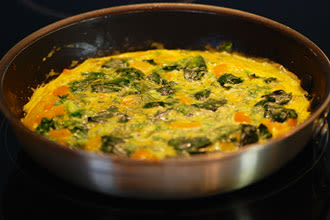
3 eggs (preferably omega-3 fortified) 1 Tbsp milk (1% or skim) 1/2 cup diced orange peppers 1/4 cup sundried tomatoes 1/4 cup frozen spinach (chopped) 1 Tbsp olive oil 1 Tbsp parsley salt and pepper
Whisk together eggs, milk, parsley, salt and pepper and set aside.
Sauté pepper and sundried tomatoes in 1 tablespoon olive oil for 1 minute over medium-high heat in a non-stick pan.
Add frozen spinach and continue cooking until spinach has thawed and cooked.
Reduce heat to low and add egg mixture, ensuring that vegetables and eggs are evenly distributed in the pan.
Cook on low heat until top of frittata begins to cook, approximately 5 minutes. Make sure the bottom does not burn. Flip frittata by placing a plate over top of pan, flip the pan and slide frittata back into pan. Cook on low for another 1-2 minutes. Alternatively, place ovenproof pan in oven and broil on low for 3 minutes or until top of frittata is cooked.
Remove from heat and let sit for 10 minutes.
The frittata can also be enjoyed at room temperature or even cold the next day.
Who Created Our Eye-Healthy Recipes?
Optometrists Dr. Laurie Capogna and Dr. Barbara Pelletier have co-authored books on eye nutrition, which you can order at www.eyefoods.com.
Eyefoods: A Food Plan for Healthy Eyes is a guide to improving eye health and preventing, suppressing and slowing common eye disorders through healthy eating. The book outlines which foods offer the most nutrients for your eyes and includes tips, meal ideas and recipes.
Eyefoods for Kids: A Tasty Guide to Nutrition and Eye Health explains to kids how the eyes work and what the various nutrients are in eye-healthy foods. It also offers delicious recipes that children can make for themselves.
Celebrity chef Anna Olson is the host of Food Network Canada's "Bake with Anna Olson." Her Niagara Springtime Soup Sipper and Sunset Gazpacho recipes were developed specifically for an event with the Eyefoods authors. Visit www.foodnetwork.ca for more information and recipes.
READ NEXT: 8 tips for healthy eyes
The relationship of dietary omega-3 long-chain polyunsaturated fatty acid intake with incident age-related macular degeneration: AREDS report no. 23. Archives of Ophthalmology. September 2008.
Oily fish consumption, dietary docosahexaenoic acid and eicosapentaenoic acid intakes, and associations with neovascular age-related macular degeneration. The American Journal of Clinical Nutrition. August 2008.
Associations between lutein, zeaxanthin, and age-related macular degeneration: An overview. Critical Reviews in Food Science and Nutrition. April 2009.
Associations between intermediate AMD and lutein and zeaxanthin in CAREDS. Archives of Ophthalmology. August 2006.
Progression of age-related macular degeneration: association with dietary fat, transunsaturated fat, nuts and fish intake. Archives of Ophthalmology. December 2003.
Page published on Saturday, April 6, 2019







